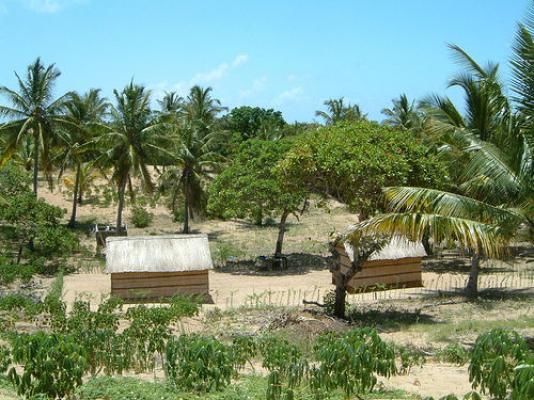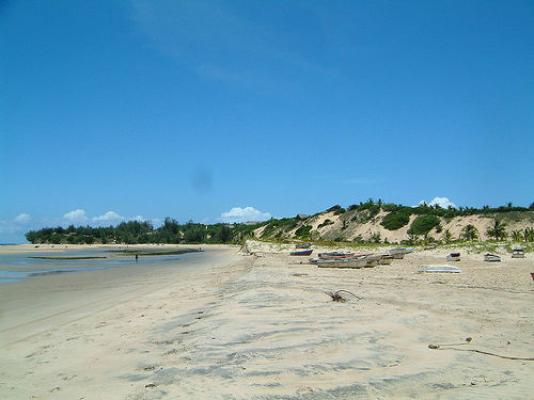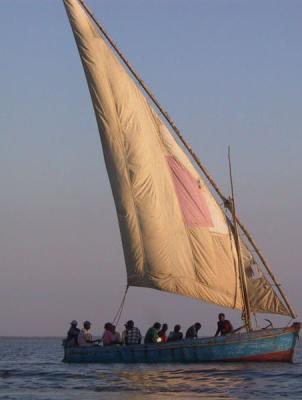Mozambique Tours & Safaris | Map of Mozambique | Mozambique Visitors Information
Mozambique is one of the larger countries in the world with a coastline of 2500 km and is divided into ten provinces and one capital city with provincial status.
Maputo
Famous because of Delagoa Bay (Baa do Esprito Santo) where the capital,
Maputo, is located, this province has a rare charm provided by the contrast between urban and rural ways of life.
The province borders South Africa and Swaziland and is very accessible.
Gaza
Gaza province is known as the "granary" of Mozambique because of the fertility of the Limpopo valley where there is extensive cereal and rice cultivation.
The provincial capital of
Xai Xai is 224 km from Maputo and the nearby beach (10km) is a popular tourist destination. There are several hotel and restaurants in the town, however, the majority of tourists prefer to stay at the beach, Praia do Xai Xai.
The massive reef running parallel to the beach provides natural protection against the strong waves at high tide and forms several small pools at low tide. At low tide, the reefs are invaded by women and children gathering shellfish, which they sell to appreciative tourists.
About 145 km north of Maputo (EN 1) is the small town of Macia which is the turning for Bilene, some 30 km further. Bilene lies on the shore of a huge, 27km long lagoon of clear, brackish water and fine, white sand.
The Banhine National Park, situated between the Limpopo and Changane rivers, is an important area, protected due to its rich variety of wildlife.
Inhambane
Inhambane province is characterised by its extensive coconut palms and cashew trees. This province has one of the most famous tourist destinations of the country; the
Bazaruto Archipelago.
Cathedral of Our Lady of the Conception is an old and imposing church in the town of
Inhambane, with a fine clock tower which was built by the Portuguese about 200 years ago.
This province has innumerable famous beaches, amongst which are: Praia de Zavala (11 km from Quissico), Praia de Zvora (85 km south of Inhambane), Baa dos Cocos (Coconut Bay) and Praia do Tofo (22 km east of Inhambane), Praia da Barra (20 km north of Inhambane) and Pomene (174 km north of Inhambane).
The Bazaruto Archipelago consists of four islands (Bazaruto, Benguera, Magaruque and Santa Carolina). They are situated off mainland between
Vilanculos and Inhassoro (780 km from Maputo).
There are high quality hotels on the islands. To reach the islands it is possible to hire a boat locally, or to travel by air from Maputo and Beira or to fly directly from a neighbouring country via Vilanculos where there are immigration and customs services.
Zinave National Park and Bazaruto National Park are conservation areas.
Sofala
Sofala is one of the richest Mozambican provinces producing primarily shrimps and sugar.
The provincial capital, Beira, is built on a plain below sea level. The city spreads along the coast from the port to the lighthouse in the Macuti area.
Worth visiting are:
Largo do Municpio - in the heart of the city, this square is surrounded by old colonial style buildings, terraces, tea rooms and shops.
Casa Portugal - a house built in a typical colonial style. It is located near the Praa do Metical.
Casa Infante de Sagres - a beautiful house of magnificant architecture. It is found in the Largo Infante Sagres.
Casa dos Bicos - an architecturally innovative building is used for exhibitions and trade fairs. It is situated on Av. Samora Machel.
Beiras best beaches are found between the Clube Nutico and the lighthouse. "Six Miles" is a resort situated inland about 10 km from the city centre. Here there is an artificial lagoon with islands where you may swim and pedal boats are available for hire.
For game viewing, there is the famous Gorongosa National Park, 150 km from Beira, and the Marromeu Buffalo Reserve, to the north of the province. In both areas there are restocking programmes underway.
Manica
The province is an important producer of a wide range of fruits and vegetables.
Chimoio, the capital city of Manica Province, is an important commercial centre for the trade of agricultural products which comes in from the surrounding fertile areas. Cabea do Velho (Face of the Old Man) - the most well known feature of the city is a spectacular natural stone formation resembling the face of an old man.
Chicamba Real is an hydroelectric dam between Manica and Chimoio. It is a stunning situation with the sheered off rock forming a natural V-shape to house the dam.
About 45 km from Chimoio towards the Machipanda border there is a sign for Casa Msika, a tourist resort on the edge of Lake Chicamba with chalets, a campsite and a pool. This is the ideal place for a fisherman or an ardent bird watcher. Visitors are also invited to visit the crocodile farm nearby.
Zambezia
Zambezia is an agricultural region of extensive coconut and magnificent tea plantations. Quelimane, the main city, is an important river port, located on the Rio dos Bons Sinais. In the city you'll find the Old Cathedral - a magnificent and austere building - and the Mosque - a modern building with ornate lattice-work at the top of the facade.
Praia de Zalala is a wonderful beach of endless white sand and is reached from Quelimane by 45 km of tarred road to the northeast. The beach is lined by dense and leafy casuarina trees.
The mountain region in the northern part of the province has extensive areas of tea plantations.
Gil Game Reserve is a wildlife conservation area with a great variety of mammal and d species.
Tete
Tete province is well known as the location of the colossal Cabora Bassa dam and is also rich in minerals, such as coal, iron, fluorite and gold.
Tete, the main town, is one of the hottest parts of Mozambique as it lies on a plateau 500 m above sea level.
Worth visiting are:
The Tete Suspension Bridge - crossing over the Zambezi river this bridge links Tete to Moatize. It was built at the end of 1960s.
Boroma Church - about 30km from Tete, this magnificant Jesuit Church was built at the end of the 19th century.
Cabora Bassa Dam - is the second largest dam in Africa and the fifth largest in the world. The enormous reservoir behind the dam has a surface area of more than 2,000 sq. km. You must obtain a written permission to visit the dam from the "Hidroelctrica de Cabora Bassa" (HCB) office in Tete before travelling to Songo (150km from Tete), where guided tours to the power station and dam are available.
Nampula
Nampula province presents contrasting scenery. The miombo forest alternates with the magnificent towering granite domes and peaks, a paradise for rock climbers.
The capital city, Nampula, is an inland town surrounded by flat plains dotted by rocky granite outcrops. Nampula Cathedral is a remarkable building with twin towers and massive dome.
Nampula Museum have displays of the diverse forms of art typical of Mozambican culture.
The old part of the Mozambique Island, about two third of its total area, was declared a "World Heritage Site" by UNESCO in 1992. Here there are buildings constructed out of coral, although many are in a poor condition due to the lack of maintenence in recent years.
Places of interest include: St. Pauls Palace, The Museum of Sacred Art and The Fortress of St Sebastian.
Popular beaches are:
Praia de Ferno Veloso. Located near Nacala 80 km north of Mozambique Island.
Praia das Chocas. Near Moambique Island, on the mainland, is a very popular beach.
Cabo Delgado
The most northerly province of the country is the home of the Makonde group of people. The Makonde are known as artists, particularly for their wood and ivory carvings.
The city of
Pemba, located on the large bay of the same name, has little industrial activity and thus its natural beauty has been preserved and its beautiful beaches are untouched by pollution. The old town contains several traditional markets where you can admire the silversmiths at work on their verandas. These craftsmen transform coins into silver necklaces, bracelets and ear-rings.
Praia do Wimbe is a palm-lined beach with white sand and blue clear waters.
Ibo Island is a beautiful island and part of the idyllic Quirimbas Archipelago. In historic times, it was an important Portuguese trade post. To visit the island you can hire a boat in Pemba for the crossing.
Niassa
Niassa province is the largest and the most sparsely populated region of the ten provinces of Mozambique. It is bordered by Tanzania in the north and Malawi in the west. The largest town is Lichinga, located on the plateau of the same name. The surrounding countryside is characterised by extensive pine forests.
A visit to Lake Niassa is obligatory if you want to have a "real Africa" experience. The journey down to the edge of the lake has to be in a 4x4 vehicle due to the quality of the road, thus the lake is inaccessible to many tourists and still unspoilt.
The Niassa Reserve to the north of the province is famous for its large number of elephants.





